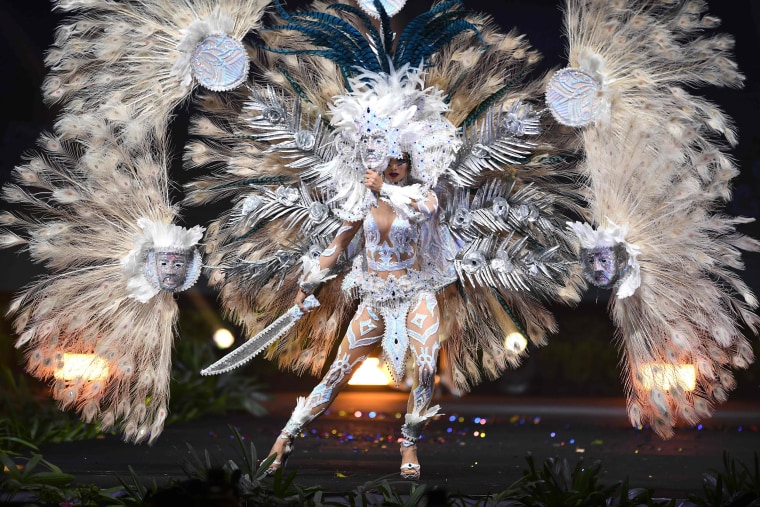This weekend marks the 67th Miss Universe pageant, the American-based international beauty competition, and the most recognizable of the four biggest international pageants for U.S. viewers. (The other three, UK’s Miss World, Japan’s Miss International and the environmentally oriented Miss Earth, are not broadcast on any major channels in this country.)
But unlike the Miss USA pageant that leads up to Miss Universe, or their rival contest Miss America, the Miss Universe pageant has a reason for viewers to tune in other than swimsuits and evening wear: national costumes. The national costume portion of the event differentiates the show from other pageants — without it, Miss Universe would frankly have very little to offer. This is not to say that Miss Universe is any less sexist than its more geographically limited peers. But it gives the contestants a way to show creativity and personality in clothing, an arguably far more effective medium in a beauty pageant than the current talent or interview portions.
Despite its name, this contest has always been a rather American conception. The first Miss Universe contest originated in Texas back in the 1920s, as a way to raise Galveston’s profile as a tourist attraction. But with the Great Depression and World War II, the event folded. The idea was revived in the early 1950s, when Catalina Swimwear, the swimsuit company that sponsored Miss America at the time, broke away to form its own contest, Miss USA. To differentiate itself from Miss America, the company decided it would create another level of pageant, an international competition, that Miss America winners couldn’t compete in. Thus, the current iteration of the Miss Universe contest was created.
The early years only had a few Western European countries send competitors, with winners hailing from places such as Finland, Sweden and France. But the contest has gradually expanded its reach. This year’s Miss Universe 2018 will include representatives from no less than 94 countries and territories across the world. Even as the standard of beauty for these pageants has narrowed — most contestants all sport a certain interchangeable, westernized aesthetic — the Miss Universe pageant is at least geographically quite diverse.
Said diversity is best summed up by the pageant’s most interesting and fun competition of the two-week event, the national costume contest. First introduced in 1962, this portion of the competition features outfits chosen to best represents each contestant’s home country or territory, usually rendered in sequins, feathers, fringe and of course, gigantic headpieces. The most elaborate outfits can turn the contestant into walking, smiling parade floats.
This element of the competition was supposed to be a way for contestants to differentiate themselves in contrast to the more mundane evening gowns and swimsuits. But from the beginning, the pageant has often rewarded the more westernized and sexed-up designs. The first winner in 1962 was Miss England, who sported a look online Halloween costume stores might label “Sexy Beefeater.”
The competition does not directly affect the scores of the contestants, but it remains one of the most popular events. This year’s “National Costume Show,” as it is officially called, was technically held last week and streamed live on YouTube. One of the reasons this portion of the show is held so early is to give fashion blogs and lifestyle-oriented sites a chance to upload slideshows of some of the wildest looks. This helps promote Sunday night’s contest so that audiences will tune in to watch the full (pre-taped and edited) presentation.
That the contest celebrates the heritages of its contestants does not mean Miss Universe is somehow more opened minded or less sexist than its partner, Miss USA. Far from it. After all, this is the organization that was once owned and operated by Donald Trump. (The infamous pee tape allegedly was recorded the weekend Trump was in Moscow for the 2012 Miss Universe pageant.) Both Miss USA and Miss Universe are now owned and operated by WME/IMG talent agency — Trump sold them in 2015 — but the values haven’t changed.
Like the national Miss USA version held back in May, Miss Universe is betting that there is still an audience that wants to watch impossibly thin and tall women parade around in various outfits for fun and prizes, and to be fair, the national costume portion is just that. But unlike Miss America’s talent portion, or the often mocked interview portions, it takes advantage of the visual medium of presentation.
Like the national Miss USA version held back in May, Miss Universe is betting that there is still an audience that wants to watch impossibly thin and tall women parade around in various outfits for fun and prizes
This is not a show trying to modernize the way Miss America is, and there’s very little chance Miss Universe will reflect any self-awareness post-#MeToo. Like the current Miss USA, Sarah Rose Summers, it’s likely the next Miss Universe will be rewarded for being as bland and innocuous as possible. This is one reason the national costumes do not count towards the final score, as they show far more personality than the judges are looking to reward. Provided, of course, that host Steve Harvey calls the correct name come crowning time. (That being said, Summers’ chances were probably sunk earlier this week when she was caught making an openly racist comment about one of her fellow contestants.)
Miss Universe does bring in better numbers for broadcaster Fox than Miss USA, with the 2017 pageant landing 4.4 million viewers last year. (In comparison, Miss USA 2017 brought in 2.9 million and Miss USA 2018 brought in 2.3 million.) And the national costumes portion is certainly one reason why. We don't need a pageant to see swimsuits and gowns, but opportunities to watch someone wearing an iridescent elephant, or bringing a couple of puppet friends on stage are far harder to come by.


